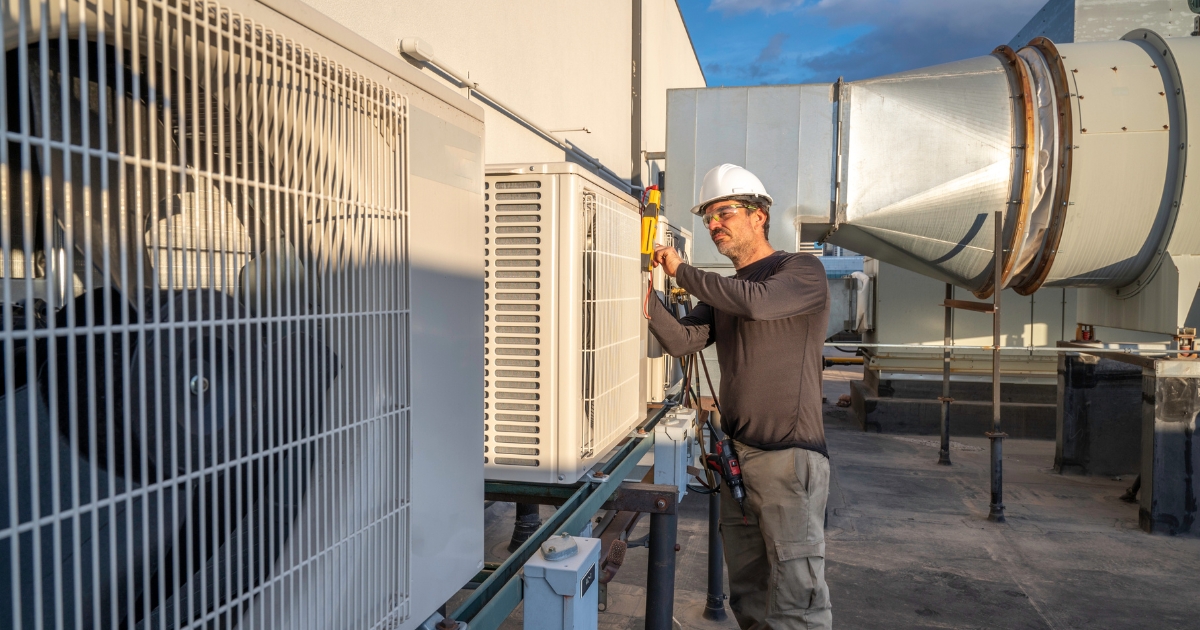Start Here: What is a Split System HVAC?
If you’re asking what is a split system HVAC, the answer is simple: it’s a heating and cooling system made up of at least two units, one located inside your home and the other outside. This setup efficiently cools or heats your home by transferring heat between these two units.
- Inside Unit: Air handler
- Outside Unit: Condenser
- Linked by: Refrigerant lines
Split systems are popular because they’re effective in maintaining comfortable indoor temperatures, even in extreme weather.
- Overview: Split systems, a common form of central air conditioning in the U.S., excel in home comfort by moving heat rather than creating cold. Essentially, they capture heat from indoors and move it outside, making them highly efficient for home cooling.
- Importance: These systems offer numerous benefits, including greater energy efficiency, customizable zoning, and quieter operation. They also contribute to improved indoor air quality by reducing humidity levels. Since indoor comfort is essential, especially in Central Massachusetts, split systems are an excellent choice.
- Indoor Air Systems: At Indoor Air Systems, we specialize in installing, maintaining, and troubleshooting various split systems. Our expert team ensures that your home remains comfortable year-round with reliable and cost-effective solutions custom to your needs.
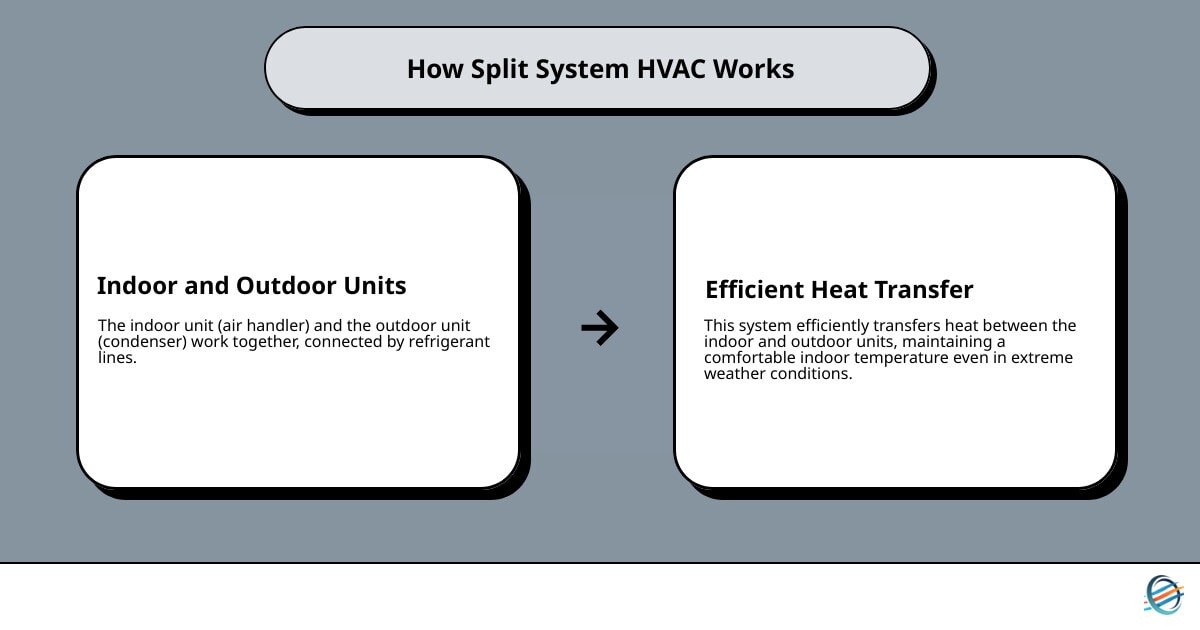
Table of Contents
A split system HVAC is a type of heating and cooling system that has separate indoor and outdoor units connected by copper tubing. This setup is designed to efficiently regulate the temperature in your home.
Components of a Split System HVAC
Indoor Unit:
- Air Handler: This component contains the evaporator coil and a fan that circulates air through your home.
- Evaporator Coil: Absorbs heat from the indoor air, cooling it down before it’s blown through the ductwork.
Outdoor Unit:
- Compressor: Pumps refrigerant through the system, enabling heat transfer.
- Condenser Coil: Releases the absorbed heat into the outdoor air.
A central air system can refer to both traditional split systems and packaged HVAC units, which consolidate all components into a single outdoor unit. These systems offer various applications and benefits depending on the home setting.
How It Works
The indoor and outdoor units are connected by copper tubing that carries refrigerant between them. Heat pump systems are versatile HVAC solutions that provide both heating and cooling, highlighting their energy efficiency and suitability for various climates. Here’s a simplified breakdown:
- Heat Absorption: The indoor unit’s evaporator coil absorbs heat from the air inside your home.
- Heat Transfer: The refrigerant carries this heat through the copper tubing to the outdoor unit.
- Heat Release: The outdoor unit’s condenser coil releases the absorbed heat into the outside air.
Why Choose a Split System HVAC?
Split systems are popular because they are efficient, customizable, and can handle extreme temperatures. They offer better energy efficiency compared to other systems and can also be customized to meet specific needs.
A split air conditioning system consists of indoor and outdoor units, highlighting its energy efficiency and suitability for various home sizes and climates.
For example, a ductless mini-split system is ideal for homes without existing ductwork, while traditional split systems work well in homes with more space.
At Indoor Air Systems, we specialize in providing reliable and cost-effective split system solutions custom to your needs.
Next, we’ll dig into how these systems work in more detail, explaining the process of heat transfer, the role of refrigerant lines, and the function of each component.
How Does a Split HVAC System Work?
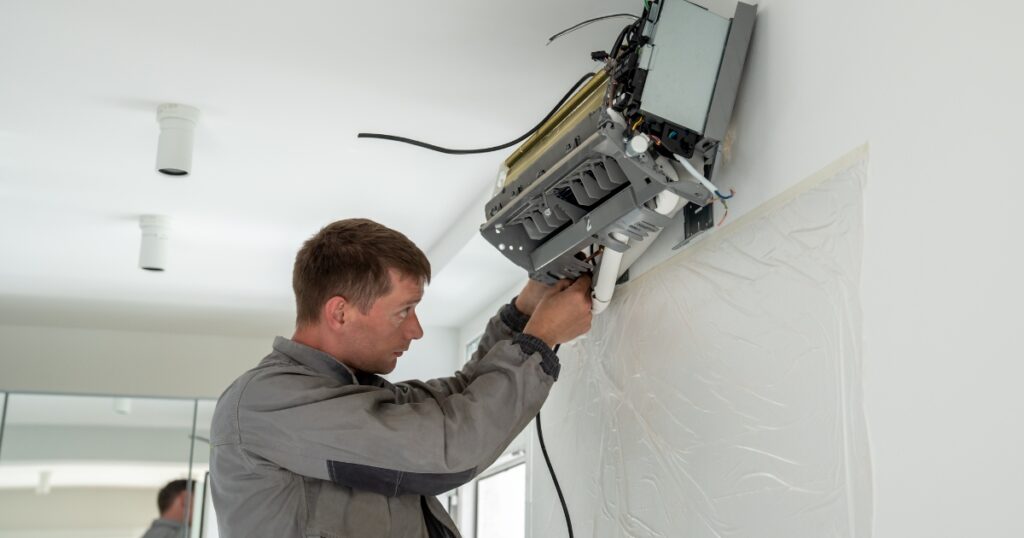
Understanding how a split system HVAC works can help you appreciate its efficiency and effectiveness. Let’s break it down into simple steps.
Heat Transfer
The main job of a split system HVAC is to move heat from one place to another. This process is essential for both heating and cooling your home.
The Role of Refrigerant Lines
Refrigerant lines are copper tubes that connect the indoor and outdoor units. These lines carry a special liquid called refrigerant. The refrigerant absorbs heat from the indoor air and releases it outside.
Components at Work
- Air Handler (Indoor Unit):
- Evaporator Coil: The evaporator coil is inside the air handler. It absorbs heat from the indoor air. As warm air passes over the coil, the refrigerant inside absorbs the heat, cooling the air.
- Condenser (Outdoor Unit):
- Compressor: The compressor pumps the refrigerant through the system. It increases the pressure of the refrigerant, turning it from a gas to a liquid.
- Condenser Coil: The condenser coil releases the absorbed heat into the outside air. The refrigerant, now a high-pressure gas, releases its heat and turns back into a liquid.
Selecting the right split HVAC system based on regional climate conditions is crucial for maintaining comfort in various weather situations.
How Indoor and Outdoor Units Come Together
Here’s a step-by-step look at the process:
- Heat Absorption: The air handler’s evaporator coil absorbs heat from your home’s indoor air.
- Heat Transfer: The refrigerant carries this heat through the copper tubing to the outdoor unit.
- Heat Release: The condenser coil in the outdoor unit releases the absorbed heat into the outside air.
- Air Circulation: The cooled air is then circulated back into your home by the air handler.
This cycle repeats until your home reaches the desired temperature set on your thermostat.
Key Points
- Heat Transfer: Moves heat from inside to outside (or vice versa in heating mode).
- Refrigerant Lines: Carry heat-absorbing refrigerant between indoor and outdoor units.
- Air Handler: Contains the evaporator coil to absorb heat from indoor air.
- Condenser: Releases absorbed heat into the outdoor air.
Understanding these steps helps you see why split systems are so efficient at regulating indoor temperatures.
Next, we’ll explore the different types of split system HVAC units and how they can be custom to fit your home’s specific needs.
Types of Split System HVAC Units
Split system HVAC units come in various types, each designed to meet specific heating and cooling needs. Understanding these types can help you choose the best system for your home.
HVAC split systems offer various advantages, types, and installation aspects, highlighting their growing popularity among homeowners.
Heat Pumps
Heat pumps are versatile units that provide both heating and cooling. They work by transferring heat from one place to another. In cooling mode, they move heat from inside your home to the outside. In heating mode, they do the opposite, drawing heat from the outside air and bringing it indoors.
- Efficiency: Heat pumps are highly efficient, especially in mild climates.
- Dual Functionality: They eliminate the need for separate heating and cooling systems.
Air Conditioners
Split air conditioning systems are focused solely on cooling. They consist of an indoor unit (evaporator coil and air handler) and an outdoor unit (compressor and condenser coil).
- Cooling Only: Ideal for hot climates where heating is not necessary.
- Effective Cooling: These systems are excellent at maintaining a comfortable indoor temperature during the summer.
Split HVAC systems are known for their efficiency and flexibility in temperature control, making them a popular choice for homeowners.
Furnaces
Furnaces in split systems provide heating by burning fuel such as natural gas, propane, or using electricity. They are typically paired with an air conditioner or heat pump for a complete HVAC solution.
- Fuel Options: Available in gas, propane, or electric models.
- Reliable Heating: Furnaces are effective in colder climates where robust heating is required.
Fan Coils
Fan coils are indoor units that work with heat pumps or air conditioners. They circulate air over a coil to heat or cool it, depending on the season.
- Versatile: Can be used for both heating and cooling.
- Space-Saving: Compact units that fit well in smaller spaces.
Ducted Systems
Ducted split systems use a network of ducts to distribute air throughout your home. The indoor unit is connected to the ductwork, which channels heated or cooled air to different rooms.
- Whole-House Solution: Ideal for homes with existing ductwork.
- Even Distribution: Ensures consistent temperature control in all rooms.
Ductless Systems
Ductless split systems (also known as mini-splits) have no ductwork. Instead, they use individual air handlers mounted in specific rooms. Each air handler is connected to a single outdoor unit.
- Flexible Installation: Perfect for homes without existing ducts or for new additions.
- Zoning Capabilities: Allows for individual temperature control in different rooms.
Understanding the different types of split system HVAC units helps you make an informed decision based on your home’s specific needs. Each type offers unique benefits, from the versatility of heat pumps to the targeted comfort of ductless systems.
Next, let’s explore the benefits of split system HVAC units and why they might be the right choice for your home.
Benefits of Split System HVAC
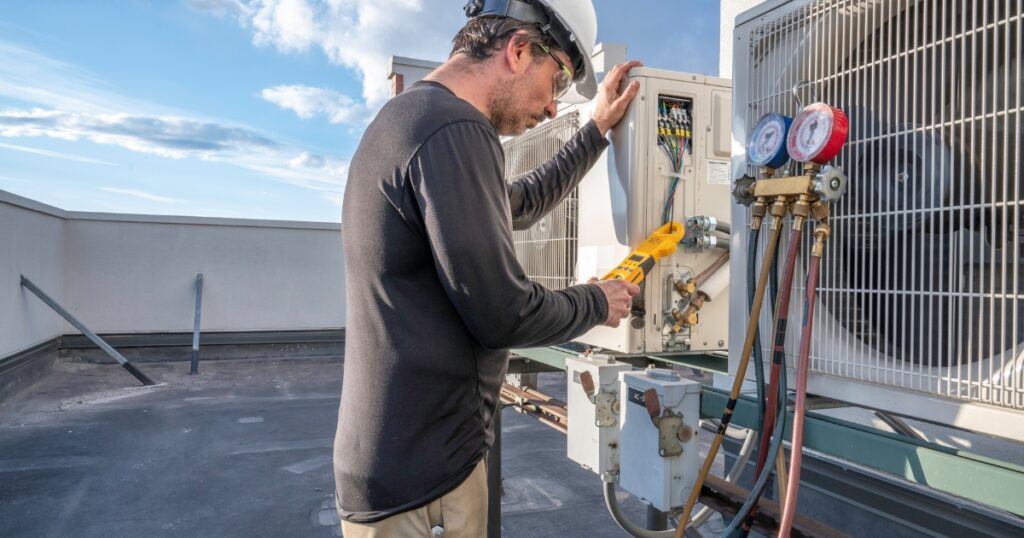
Split system HVAC units offer a range of benefits that make them a popular choice for homeowners. Let’s break down the key advantages:
Efficiency
Split systems are known for their energy efficiency. They are designed to use less power while providing effective heating and cooling. This is especially true for heat pumps, which can achieve up to four times the energy savings compared to traditional systems. By moving heat instead of generating it, split systems reduce energy consumption and lower utility bills.
Customization
One of the standout features of split systems is their customization capabilities. With ductless mini-splits, you can control the temperature in individual rooms. Each room can have its own air handler, allowing for personalized comfort. For instance, you can keep the living room cooler while maintaining a warmer temperature in the bedroom.
Zoning
Zoning is another significant benefit of split systems. With zoned heating and cooling, you can divide your home into different areas, each with its own climate control. This is particularly useful for larger homes or homes with multiple stories. Zoning helps avoid the energy waste associated with heating or cooling unused rooms.
Energy Savings
By providing precise temperature control and eliminating the need for ductwork, split systems help save energy. Traditional ducted systems can lose up to 30% of energy through ducts. In contrast, ductless systems deliver air directly to the room, reducing energy loss. This makes split systems a cost-effective option in the long run.
Noise Reduction
Split systems are often quieter than traditional HVAC units. The noisy components, such as the compressor and condenser, are located outside. This results in a quieter indoor environment. Many indoor units operate at sound levels as low as 19 decibels, which is quieter than a whisper. This makes them ideal for bedrooms and living areas where noise can be a distraction.
In summary, split system HVAC units offer efficiency, customization, zoning, energy savings, and noise reduction. These benefits make them a versatile and practical choice for homeowners looking to improve their indoor comfort.
Next, let’s discuss some potential drawbacks of split system HVAC units to consider before making a decision.
While split system HVAC units have many advantages, they also come with some potential drawbacks. Let’s explore these:
Installation Cost
Installing a split system HVAC can be more expensive than other types of systems. This is mainly because there are two separate units: one indoor and one outdoor. The installation process can be complex, especially if the units need to be installed far apart. The cost can also rise if additional work, like installing copper tubing or electrical wiring, is needed.
Outdoor Space
A split system requires outdoor space for the compressor unit. If you have a small yard or limited outdoor space, this can be a challenge. The outdoor unit also needs to be placed in a well-ventilated area, away from obstructions, which can further limit placement options.
Noise
While indoor units are generally quiet, the outdoor compressor can be noisy if not properly maintained. This noise can be a nuisance, especially if the unit is close to a bedroom or a frequently used outdoor area like a patio.
Weather Dependency
Some split system HVAC units, particularly heat pumps, may struggle in extremely cold temperatures. For instance, certain models might not perform well below 13°F. If you live in a region with harsh winters, you’ll need to choose a model designed for low-temperature performance or consider a supplemental heating source.
In summary, the main drawbacks of split system HVAC units include higher installation costs, the need for outdoor space, potential noise issues, and weather dependency. These factors should be considered to ensure you choose the best system for your home.
Next, we’ll compare split system HVAC units with packaged unit systems to help you decide which is better for your needs.
Split System HVAC vs. Packaged Unit Systems
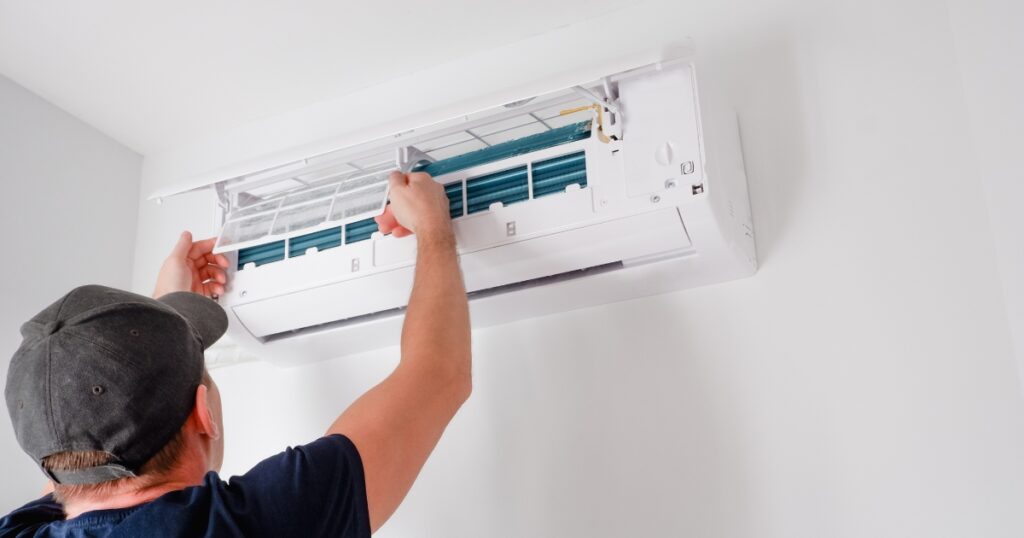
When deciding between a split system HVAC and a packaged unit system, understand the key differences in configuration, efficiency, installation, space requirements, and customization. Let’s break it down:
Configuration
Split System HVAC:
- Components: Consists of two separate units—an indoor unit and an outdoor unit. The indoor unit contains the air handler, evaporator coil, and blower fan, while the outdoor unit houses the compressor and condenser coil.
- Connection: These units are connected by copper tubing and refrigerant lines, facilitating heat transfer between the indoor and outdoor environments.
Packaged Unit System:
- Components: All components are housed in a single outdoor unit. This includes the compressor, condenser, evaporator coil, and sometimes a furnace or electric heating coils.
- Connection: The unit is connected to the home’s ductwork, which distributes air throughout the building.
Efficiency
Split System HVAC:
- Energy Efficiency: Generally more energy-efficient, especially if the system is Energy Star® certified. Efficiency ratings can go up to 24 SEER2.
- Zoning: Offers precise zoning and temperature control, allowing for different temperatures in different areas of the home.
Packaged Unit System:
- Energy Efficiency: May be less energy-efficient compared to split systems, but still meets basic efficiency standards.
- Zoning: Limited zoning capabilities, making it better suited for smaller spaces or homes with uniform temperature needs.
Installation
Split System HVAC:
- Complexity: Installation can be complex and expensive, especially if there’s no existing ductwork or if the units need to be placed far apart.
- Customization: More customizable, allowing for various configurations like adding a heat pump or furnace.
Packaged Unit System:
- Simplicity: Easier and less expensive to install since all components are in one unit.
- Customization: Fewer customization options, as all components are bundled together.
Space Requirements
Split System HVAC:
- Indoor Space: Requires indoor space for the air handler and related components.
- Outdoor Space: Needs outdoor space for the compressor unit, which can be challenging in homes with limited yard space.
Packaged Unit System:
- Indoor Space: Requires less indoor space since all components are outside.
- Outdoor Space: Needs a suitable outdoor location, usually on a cement slab or rooftop.
Customization
Split System HVAC:
- Components: Allows for a mix of components like heat pumps, air conditioners, and furnaces, providing year-round climate control.
- Flexibility: Highly customizable to meet specific heating and cooling needs.
Packaged Unit System:
- Components: Limited to the components included in the single outdoor unit.
- Flexibility: Less flexible in terms of customization and component upgrades.
In summary, choosing between a split system HVAC and a packaged unit system depends on your home’s specific needs, available space, and budget. Split systems offer higher efficiency and customization but come with higher installation costs and space requirements. Packaged units are easier to install and require less indoor space but may not be as efficient or customizable.
Conclusion
Understanding Split System HVAC can make a big difference in your home’s comfort and energy efficiency. From how these systems work to the types available, we’ve covered a lot of ground. Let’s recap and see how Indoor Air Systems can help you find the best solution for your home.
Summary
Split system HVAC units consist of two main components: an indoor unit and an outdoor unit, connected by copper tubing. They offer various types, including heat pumps, air conditioners, and furnaces. These systems are known for their efficiency, customization, and ability to heat or cool specific zones in your home.
Selecting the right HVAC system can be daunting, which is why we provide personalized consultations to make the process easier. At Indoor Air Systems, we excel in everything HVAC, offering expertise that guarantees the best system tailored to your specific needs.
Our experts will evaluate your home, understand your needs, and recommend the most suitable options. From design and configuration to installation and maintenance, our skilled technicians manage it all.
Ready to improve your home’s comfort and efficiency? Contact us today at Indoor Air Systems for a personalized consultation. Visit our services page to learn more about how we can help you with your HVAC needs.
By understanding the basics of split system HVAC units, you can make an informed decision that improves your home’s comfort and saves you money. Let Indoor Air Systems be your trusted partner in achieving the perfect indoor climate.
Frequently Asked Questions about Split System HVAC
What is the difference between HVAC and split AC?
HVAC stands for Heating, Ventilation, and Air Conditioning, encompassing the entire system that controls the climate in your home. This includes heating units like furnaces, cooling units like air conditioners, and sometimes even ventilation systems.
Split AC, on the other hand, is a specific type of air conditioning system. It consists of two units: an indoor unit that handles air distribution and an outdoor unit that houses the compressor and condenser. While all split ACs are part of HVAC systems, not all HVAC systems are split ACs.
Which is better, a split system or a package unit system?
Efficiency: Split systems generally offer higher energy efficiency. They can have SEER ratings up to 24, especially if Energy Star® certified. This means lower energy bills.
Space: Split systems require both indoor and outdoor space. The indoor unit needs a spot for the air handler and evaporator coil, while the outdoor unit houses the compressor. Packaged units, however, house all components in a single outdoor cabinet, saving indoor space.
Cost: Installation for split systems can be more expensive due to the complexity and need for both indoor and outdoor setups. Packaged units are easier and cheaper to install but may not offer the same level of efficiency or customization.
How does a HVAC split system work?
Ducted Systems: In a ducted split system, the indoor unit, which contains the air handler and evaporator coil, distributes air through a network of ducts. The outdoor unit houses the compressor and condenser coil. Refrigerant lines connect the two units, facilitating heat transfer.
Ductless Systems: Ductless systems, also known as mini-splits, don’t use ductwork. Instead, they have smaller air handlers installed in individual rooms. These are connected to an outdoor unit via refrigerant lines. This setup allows for precise temperature control in different areas of the home.
Air Handlers: The air handler in both ducted and ductless systems is responsible for moving air over the evaporator coil to either cool or heat it, depending on the mode. The conditioned air is then distributed throughout the home or specific rooms.
By understanding these key aspects, you can better decide which system suits your home’s needs.
Our Content
At Indoor Air Systems, LLC, we provide specialized HVAC services with a personal touch. Serving Central Massachusetts, we focus on the installation and maintenance of mini-split systems, split system air conditioner, ensuring efficient and cost-effective heating and cooling solutions. Our locally owned and operated business allows us to offer exceptional customer attention and responsiveness without the high costs associated with larger companies. Choose Indoor Air Systems for reliable, expert service tailored to your specific needs.

